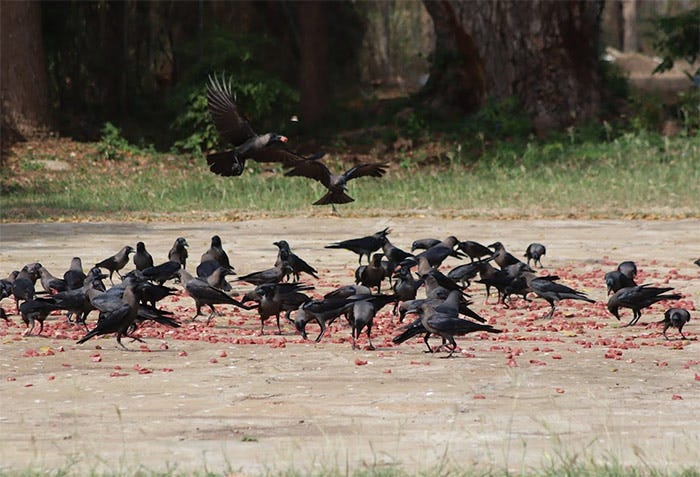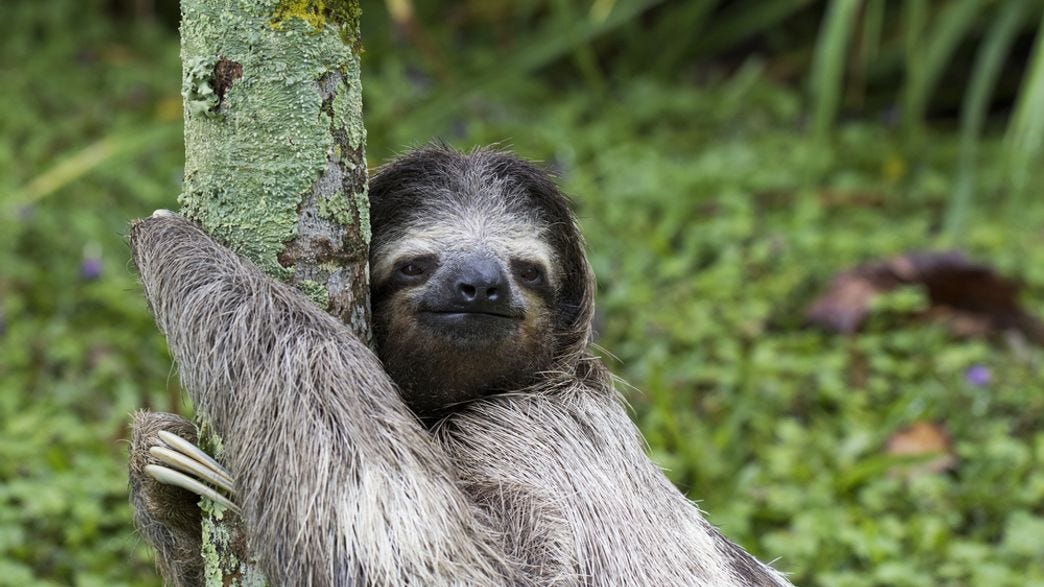BY RICHARD CONNIFF

Kenya has begun a program to poison a million Indian House Crows, an invasive species, by the end of the year, with the declared intent to protect native bird species. That approach—also being tried on the other side of the world, in the Old Growth forests of Oregon—merits a closer look.
Let’s start with Kenya. The crows originally arrived in Zanzibar in the 1890s, as a deliberate introduction to help keep down the growing accumulation of rubbish. It backfired. The crows proliferated together with the human population and our ever-increasing refuse. They soon made the leap to the East African mainland, where their range has steadily expanded. The BBC reports:
Conservationists say that the crows have significantly reduced the number of small indigenous birds in the region, such as weavers and waxbills, by ripping their nests apart while targeting eggs and even chicks
More to the point, at least politically, the crows have made themselves a nuisance to humans, damaging crops and poultry:
"They pounce on chicks and eat them like madmen. These are not normal birds, they act wildly," said Eunice Katana, a resident of Takaye village in Kilifi county.
Others complain that the birds’ raucous calling wakes them too early in the morning, that their feeding attacks disrupt people eating at tourist restaurants, and that their abundant droppings deface building and make it unwise to sit under shade trees.
People in Nairobi, the national capital, now await the steady approach of the birds with Hitchcockian dread—and a dose of poison. The culling program works by baiting the birds with meat for several months to concentrate them at a feeding site, then applying a bird poison called Starlicide. Proponents say Starlicide is metabolized by the crows before death and thus becomes harmless to animals scavenging their carcasses.
The campaign is now under way, with the approval of Kenya Wildlife Service following “months of consultations with environmental experts, conservationists, community leaders and representatives from the hotel industry.”
That process appears not to have addressed an analysis by the U.S. Environmental Protection Agency, which is readily available online:
Based on the data, non-target birds and mammals may be at risk from eating starlicide treated bait (primary exposure), or, as scavengers and predators, from consuming animals who have eaten treated baits (secondary exposure).
Bottom line: The idea of killing the invasive species to protect native birds sounds premature if it hasn’t thoroughly considered potential effects of the poison on other native species. Vultures, which provide an essential waste removal function and are already endangered in much of Africa, including Kenya, could be particularly vulnerable.
In Oregon, the plan by the U.S. Fish and Wildlife Service (USFWS) is to routinely shoot large numbers of barred owls—470,900 of them over the next 30 years. (That’s around 16,700 a year.) This predominately eastern species is now becoming increasingly common in the Pacific Northwest.
The issue is that the barred owls out-compete northern spotted owls for nesting sites in Old Growth forests there, accelerating a long decline in the species that began with large-scale loss of habitat from logging. The spotted owls have of course been the subject of bitter environmental controversy, pitting logging jobs against species and habitat protection, since the 1980s. They are currently listed as threatened under the Endangered Species Act, and USFWS notes that this law obliges it to protect them not just from loggers, but from barred owls, which it describes as an invasive species.
Early this month, The New York Times ran a remarkable opinion piece on the plan. Remarkable because the authors are philosophy educators, a group with a history of applying dubious thinking to the natural world. (See, for instance, a Rutgers University philosophy professor’s argument, also in the New York Times, for getting rid of carnivores on moral grounds. Or this one, in which philosophy scholars from other eminent universities argue for killing off predators to protect their prey.)
The owl piece, by contrast, appears at first to be well-reasoned and reality-based. In place of the USFWS narrative that barred owls have gradually moved west over the past 130 years, the authors cite
genomic evidence that the barred owl has in fact resided in the Pacific Northwest for thousands of years. The recently described genetic and phenotypic differences between western and eastern barred owl populations suggest the western barred owl is a not a new arrival. That evidence throws a wrench in the narrative that the barred owls are newcomers, and so can be considered invasive, and yet that evidence is barely mentioned in the fish and wildlife agency’s most recent Environmental Impact Statement proposing the mass killings.
The 2021 study they cite is not, however, as decisive as that sounds. Its sample of eastern barred owls is small. So the authors acknowledge the possibility of “substantial genetic variability … within the eastern barred owls,” meaning there may also be “an unsampled” eastern barred owl population from which the western barred owls have spun off relatively recently. Alternatively, barred owls may have lived in the forests of western Canada long enough to explain genetic differences with eastern populations—but only recently invaded the range of spotted owls due to “loss of boreal forests caused by the climate change and human activities.”
The Times opinion piece is also misleading about before-and-after experiments to remove barred owls, saying they merely slowed but did not stop the decline of spotted owls. In fact, one study found that removal of barred owls sharply reduced the rate of that decline. With barred owls present, spotted owl populations dropped by 84 percent over four years. With barred owls removed, the rate of decline was just 12 percent. A 2021 study they also cite, by a large team of academic, government, tribal, and industry researchers, reported that “removal of barred owls had a strong, positive effect on survival of spotted owls” and “arrested long-term population declines of spotted owls.”
Finally, the Times opinion piece argues that many conservation biologists and ecologists question the idea “that we should restore current environments to so-called historical base lines, as this plan tries to do.” But again the 2009 study they cite says something different and more nuanced: While climate change may make such restorations harder in the coming decades, “ecological restoration efforts should aim to conserve and restore historical ecosystems where viable.” [Italics added.] In reality, eradicating invasive species has repeatedly proved beneficial to native species, notably on island habitats.
Bottom line: Philosophers should stick to philosophy. In this case, the evidence argues for killing barred owls in spotted owl habitat as a necessary means of buying time for a threatened species while working to restore habitat.
THE VERY HARRIED LIFE OF SLOTH POOP
This is not technically this week in wildlife, but more like a month or two ago, when the June 3 issue of the New Yorker ran a humor piece headlined, “God Explains the Rules of His New Board Game,” the game being life as we know it. I apologize for not writing about it back then but … how can one keep up?
Well, one way is to go on vacation and bring along a small fraction of the accumulating pile of New Yorkers, which I have just done. So back to the humor piece by novelist Teddy Wayne—and to my Saturday morning mood of outrage and high dudgeon over factchecking fails.
One particular item on Wayne’s board game of life made my antennae waggle:
What? You want to quit because someone else got “acting-writing-directing triple threat Bradley Cooper” and you’re just a “pellet” in a “hot mound” of “sloth shit”? I know Bradley Cooper seems like an awesome player, especially since he is equally adept at “bromantic comedy” and “Oscar bait,” but sloth shit can be really cool, too. You get to just sit there, and everyone keeps a respectful distance. Trust me, you got lucky.
Oh, Teddy, how badly you mistake the life of sloth shit!
What nature gives sloth shit is anything but “respectful distance.” You know of course that these treetop animals only poop once a week? And that, for unknown reasons, they climb down to the base a tree to do it, potentially leaving themselves exposed to predators?
What makes this ritual even more bizarre (and here I am quoting from my book Every Creeping Thing, now sadly out of print):
is that it is the focus of intense interest among a vast group of specialized insects living in the sloth's hair … Researchers have gathered as many as 120 moths from a single sloth, and a record of 978 beetles, all of them waiting patiently for the sloth's weekly defecation, which is both a source of nutrition and an ideal site for egg laying. This population might seem even lazier and less demanding than the sloths on which they live. Adult moths, for example, sometimes break off their wings in the host's fur and remain contentedly sloth-bound for life. But the competitiveness among tropical fauna is such that some of the beetles and mites actually enter the sloth's anus to lay their eggs, gaining several days' incubation time on their less intrepid rivals.
In short, sloth shit would also happily be reincarnated as Bradley Cooper.
##
That’s all for this week. Very peaceful pooping to you all, and may you otherwise enjoy these last sweet days of summer.




